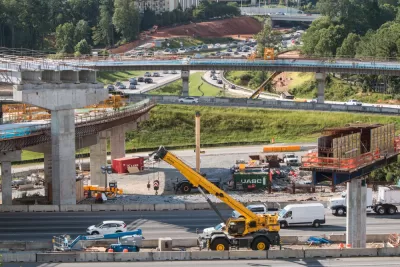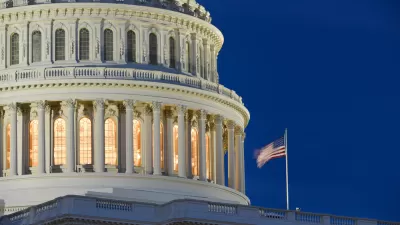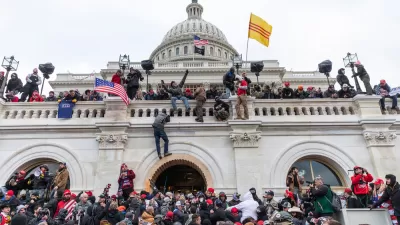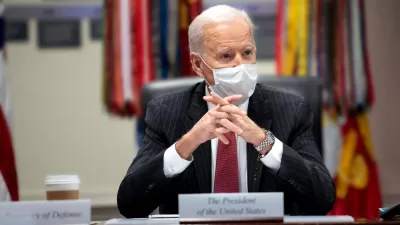With President Joe Biden scheduled to sign the Infrastructure Investment and Jobs Act today in Washington, D.C., Planetizen shares insight into the fine print of the historic bill.

There was still plenty of confusion about the Infrastructure Investment and Jobs Act (IIJA) when Congress finally approved the $1.2 trillion bill earlier this month. Ambiguity about how much spending the bill allotted (the bill includes $550 billion in new spending, for example, along with a remainder that pays for existing programs) and even what to call the bill (the bill includes neither the defunct INVEST in America Act nor the still-under-negotiation Build Back Better Act, but it does include the Surface Transportation Reauthorization Act of 2021 and the Reconnecting Communities Act).
A previous Planetizen article, published after the historic approval, discusses the recent history of federal infrastructure legislation and clears up some of the ongoing misconceptions about the IIJA, but many salient details of what, where, when, and how were still missing. These are the considerations that will come to define the IIJA—whether as a key moment in the evolution of federal infrastructure spending or as a historic missed opportunity.
Here's a roundup of recent news and advocacy coverage to reveal more details of the legislation central to this historic day.
Broad Strokes
Legislative Analysis for Counties: The Infrastructure Investment and Jobs Act – The National Association of Counties has prepared the most detailed breakdown of the spending programs included in the IIJA. Owning and operating 44 percent of public roads and 38 percent of bridges, counties will play a major role in the rollout of IIJA programs. (National Association of Counties, November 7)
America has an infrastructure bill. What happens next? – The IIJA proposes a larger building program than the New Deal during the Great Recession. The spending can't be described as an economic stimulus bill: "IIJA represents a longer-term patient approach to rebuilding American competitiveness through infrastructure." (Brookings, November, 9)
How Cities Could Spend $1 Trillion on Infrastructure: Roads, Trains and Highway Exits – A paywalled article from the Wall Street Journal surveys the local and state effort to spend the money allocated in the IIJA. (Wall Street Journal, November 9)
A 'game changer'? Mayors, governors ready to compete for $1 trillion in infrastructure funds – A paywalled article surveys the nation for examples of local and state authorities hope to spend IIJA funding. (USA Today – November 14)
US states and cities are already making big plans for the $1 trillion infrastructure bill – A paywalled article details the programs that will filter IIJA funding down from the federal government to local and state authorities. (Quartz, November 15)
The Infrastructure Bill May Not Be So Historic After All - The INVEST in America Act would have ensured that jurisdictions repair road systems before they expanding them, but the law didn't make it into the final version of the IIJA. That and other reasons for concern that the IIJA might just reinforce what's broken about infrastructure in the United States are listed here. (Governing, November 15)
Niche Interests
The infrastructure package puts $66 billion into rail. It could power the biggest expansion in Amtrak’s 50-year history. – The IIJA includes $66 billion in new funding for Amtrak. In addition to repairing and replacing existing tracks, the funding will enable the largest expansion of the Amtrak system in the system's 50-year history. The funding will also keep hopes for the $75 billion "Connect US" expansion plan alive. (The Washington Post, November 8)
‘Small Victories’ For Vulnerable Road Users In Infrastructure Bill – The IIJA includes support for programs that make walking and biking safer and more accessible, such as $1.44 billion a year for "transportation alternatives" and a requirement for states to allocate 15 percent of Highway Safety Improvement Program funds to protecting vulnerable road users. (Streetsblog USA, November 8) (Additional Planetizen coverage)
New technology mandate in infrastructure bill could significantly cut drunken driving deaths – The IIJA mandates new cars to include technology that will prevent drunk drivers from getting behind the wheel. "A recent study by the Insurance Institute for Highway Safety concluded the technology could reduce deaths by 9,400 people a year if widely deployed." The mandate could take effect as soon as 2026. (The Washington Post, November 9)
Congress mandates anti-drunk driving technology for cars – The IIJA represents the biggest push ever to eliminate drunk driving. The Department of Transportation will lead the effort to determine the best technological response to the mandate. (TechCrunch, November 10)
Infrastructure bill mandates new car technology to stop drunken driving – The drunk driving tech mandate is part of $17 billion allotted by the IIJA to road safety programs. (Associated Press via The Oregonian, November 9)
How the New Infrastructure Deal Will Make Transit Better – The $39 billion for transit in the IIJA is dwarfed by $110 billion for highway construction and repair, but there are reasons to be optimistic that the IIJA will result in more accessible, equitable, and clean public transit. (Streetsblog USA, November 9)
Infrastructure Bill Allots $65 Billion for Broadband Expansion – projects to bolster and deploy broadband internet will receive $65 billion from the IIJA. The broadband spending can be separated into four categories: deployment, emergency benefits, adoption, and miscellaneous. (Governing, November 10)
Animals need infrastructure, too – Wildlife crossings are an under-appreciated form of infrastructure, with well established benefits for both humans and biodiversity. The IIJA includes $350 million for animal-friendly infrastructure. Watch out for erroneous mentions of the IIJA as the INVEST in America Act in this article. (Vox, November 12)
Biden Plan Funds New Bridges That Locals May Not Want –The IIJA includes $40 billion for bridges, along with another $16 billion for major projects that can also include bridges, far surpassing the typical $7 billion a year in federal funding for bridges. Some of the bridge projects enabled by IIJA funding could experience local opposition, however. (Bloomberg CityLab, November 12)
Buttigieg’s star rises as $1T Biden agenda shifts toward him – About $120 billion of the $550 billion in new transportation spending in IIJA will be allocated in competitive grant programs administered by the Department of Transportation. Transportation Secretary Pete Buttigieg recently spent time in the limelight after commenting about the racist history and legacy of U.S. transportation planning targeted by the "Reconnecting Communities" pilot program included in the IIJA. (Associated Press via Pittsburgh Post-Gazette, November 15)
Geographic Specificity
Clean fuels and clean water: what's in the infrastructure bill for Washington – Three transportation agencies in the Seattle area will receive 1 billion, along with funding for water infrastructure, bridge repair and replacement, climate change resilience, and cyber security. The state will also receive $4.7 billion for state highway repair and maintenance. (KUOW, November 9)
What Minnesota is getting from the new federal infrastructure bill – Minnesota is set to receive $6.8 billion from the IIJA, with the bulk of that total for roads and bridges. (MinnPost, November 9)
ODOT to get $1 billion in new funding from federal infrastructure package – The potential funding windfall for the state of Oregon includes money for freeways, transit, and clean energy, though the federal government will still have a final say on how much money ends up in the state's hands. It's clear, however, the windfall is larger for the state's highway agencies than its transit agencies. (The Oregonian, November 9)
Maine expects nearly $2.4 billion from Biden infrastructure package – The state of Maine expects to receive about $2.37 billion in direct funding over five years from the IIJA. That total includes about $100 million for broadband internet, $19 million for electric vehicle charging stations, and $230 million for public transit. More than half the state's total, $1.3 billion, will go to highways. (Press Herald, November 9)
Boogie Down Biden: Pols, City DOT Hail Fed Funds for Capping the Cross Bronx Expressway – The IIJA includes the "Reconnecting Communities" pilot program, which will award $2 million grants to study the feasibility of highway removal projects. Local politicians and advocates home the new program can kickstart the removal of the Cross Bronx Expressway in New York City. (Streetsblog NYC, November 9)
Idea of ‘Tearing Down the BQE’ Gets Fresh Look as Feds Open Their Wallets – The "Reconnecting Communities" program, along with an incoming may and a forthcoming gubernatorial election, has given a shot in the arm to an effort to remove, rather than replace, the Brooklyn-Queens Expressway in New York City. (Streetsblog NYC, November 11)
Arizona better get cracking if we want cash for water in the infrastructure bill – The IIJA offers Arizona a chance to finally act to augment its water supplies—whether through desalination, recycling, a new pipeline, or rainwater capture and reuse. The water supply project most likely to benefit from IIJA funding is the Bartlett Dam Expansion. (Arizona Republic, November 14)
Bridge and Road Repairs Ahead, but Where? – The IIJA is expected to fund the extension of the Second Avenue subway in Manhattan and a plan for a new railroad tunnel between New York and New Jersey (i.e., the Gateway Project). (The New York Times, November 15)
What the Infrastructure Bill Means for the New York Region – More details on the potential of the IIJA to "transform New York City and its surrounding region." (The New York Times, November 15)
President Joe Biden to sign infrastructure bill that will bring more than $9 billion to Massachusetts projects over five years – The IIJA is expected to bring $9 billion to Massachusetts over the next five years, including $4.2 billion for highways, $1.1 billion for bridge repairs, $2.5 for the MBTA, and $1.1 billion for water infrastructure. (Mass Live, November 15)
Biden signs $1.2T infrastructure bill - Nevada's $4 billion allotment from the IIJA includes $2.5 billion for highway projects, potentially including Interstate 15 between Las Vegas and Los Angeles and Interstate 11 from Las Vegas to Phoenix. (Las Vegas Review-Journal, November 15)

Maui's Vacation Rental Debate Turns Ugly
Verbal attacks, misinformation campaigns and fistfights plague a high-stakes debate to convert thousands of vacation rentals into long-term housing.

Planetizen Federal Action Tracker
A weekly monitor of how Trump’s orders and actions are impacting planners and planning in America.

San Francisco Suspends Traffic Calming Amidst Record Deaths
Citing “a challenging fiscal landscape,” the city will cease the program on the heels of 42 traffic deaths, including 24 pedestrians.

Defunct Pittsburgh Power Plant to Become Residential Tower
A decommissioned steam heat plant will be redeveloped into almost 100 affordable housing units.

Trump Prompts Restructuring of Transportation Research Board in “Unprecedented Overreach”
The TRB has eliminated more than half of its committees including those focused on climate, equity, and cities.

Amtrak Rolls Out New Orleans to Alabama “Mardi Gras” Train
The new service will operate morning and evening departures between Mobile and New Orleans.
Urban Design for Planners 1: Software Tools
This six-course series explores essential urban design concepts using open source software and equips planners with the tools they need to participate fully in the urban design process.
Planning for Universal Design
Learn the tools for implementing Universal Design in planning regulations.
Heyer Gruel & Associates PA
JM Goldson LLC
Custer County Colorado
City of Camden Redevelopment Agency
City of Astoria
Transportation Research & Education Center (TREC) at Portland State University
Jefferson Parish Government
Camden Redevelopment Agency
City of Claremont






























